Abstract
Risk characterization involves hazard identification, determination of dose-response relationships, and exposure assessment. Improvement of the risk assessment process requires inclusion of the best available science. Recent findings in the area of dioxin toxicity have led to a major effort to reassess its risk. 2,3,7,8-Tetrachlorodibenzo-p-dioxin (TCDD), commonly referred to as "dioxin," is the most toxic member of a class of related chemicals including the polyhalogenated dibenzo-p-dioxins, dibenzofurans, biphenyls, naphthalenes, azo- and azoxy-benzenes, whose toxicities can be expressed as fractional equivalencies of TCDD. These chemicals exert their effects through interaction with a specific intracellular protein, the Ah receptor. While binding to the receptor is necessary, it is not sufficient to bring about a chain of events leading to various responses including enzyme induction, immunotoxicity, reproductive and endocrine effects, developmental toxicity, chloracne, tumor promotion, etc. Some of these responses appear to be linear at low doses. Immunotoxicity and effects on the reproductive system appear to be among the most sensitive responses. The Ah receptor functions as a transcriptional enhancer, interacting with a number of other regulatory proteins (heat shock proteins, kinases, translocases, DNA binding species). Interaction with specific base sequences in the DNA appear to be modulated by the presence of other growth factors, hormones and their receptors as well as other regulatory proteins. Thus, dioxin appears to function as a hormone, initiating a cascade of events that is dependent upon the environment of each cell and tissue. While Ah receptor variants exist, all vertebrates examined have demonstrated such a protein with similar numbers of receptors and binding affinity for TCDD. Most species respond similarly to dioxin and related compounds. While a given species may be an outlier for a given response, it will behave like other animals for other responses. For both in vivo and in vitro end points where animal and human data exist, such as enzyme induction, chloracne, immunotoxicity, developmental toxicity, and cancer, the sensitivity of humans appears similar to that of experimental animals. Current levels of environmental exposure to this class of chemicals may be resulting in subtle responses in populations at special risk such as subsistence fisherman and the developing infant, as well as in the general population. Increased understanding of the mechanism of dioxin's effects as well as elucidation of exposure-dose relationships is leading to the development of a biologically based dose-response model in the ongoing process of incorporating the best science into the risk assessment of TCDD and related compounds.
Full text
PDF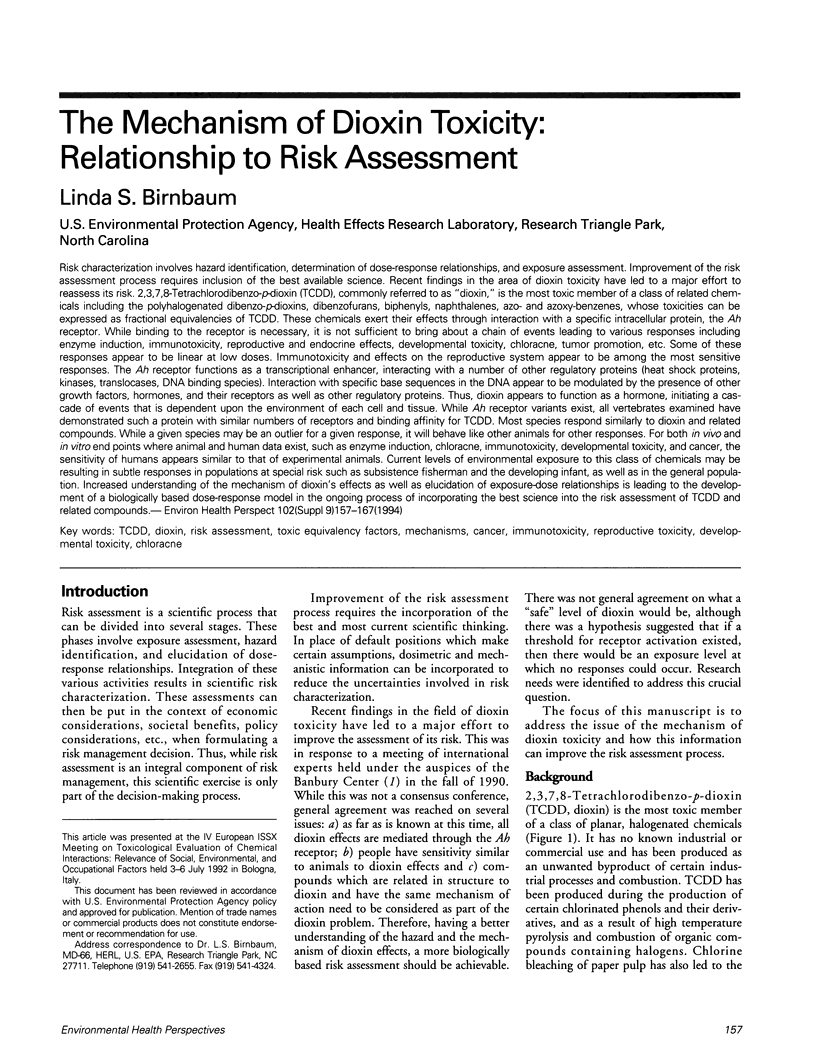
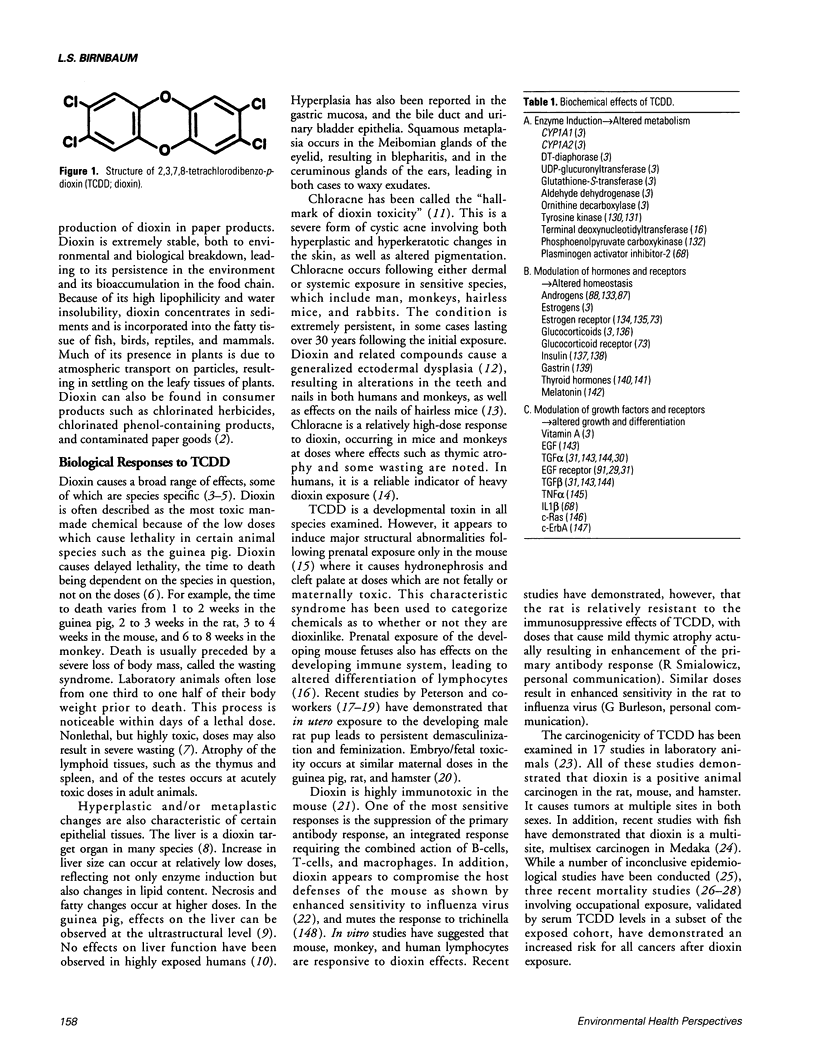
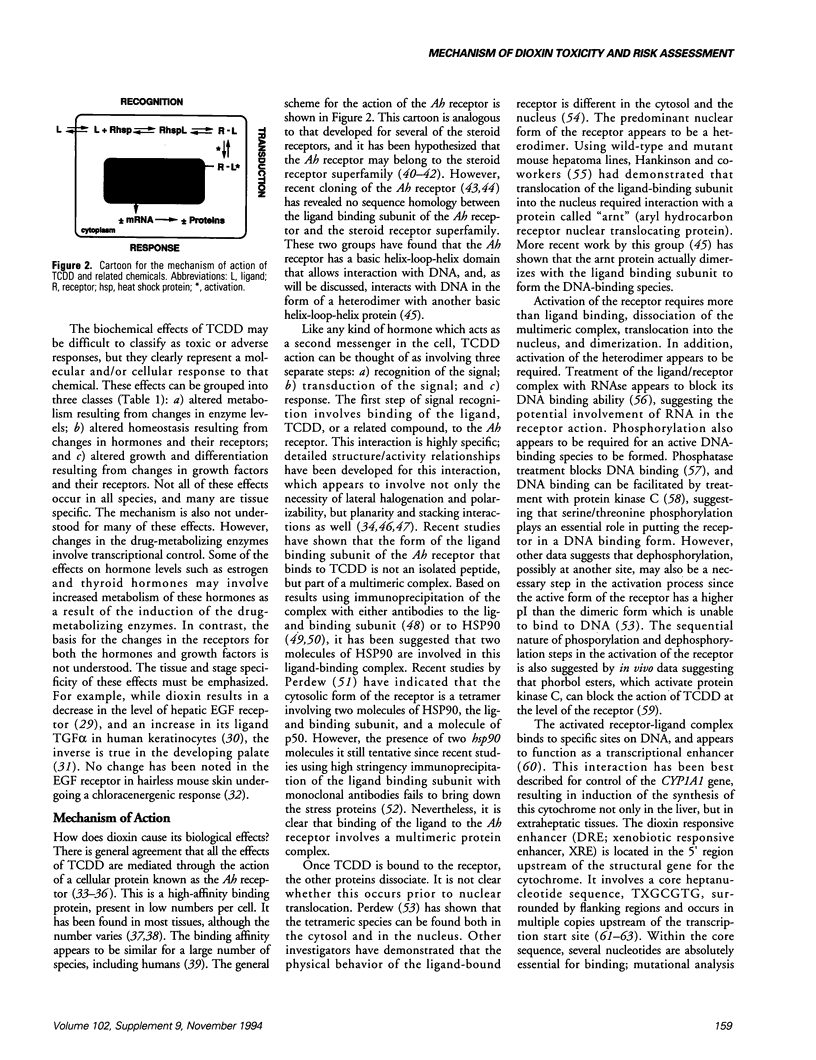
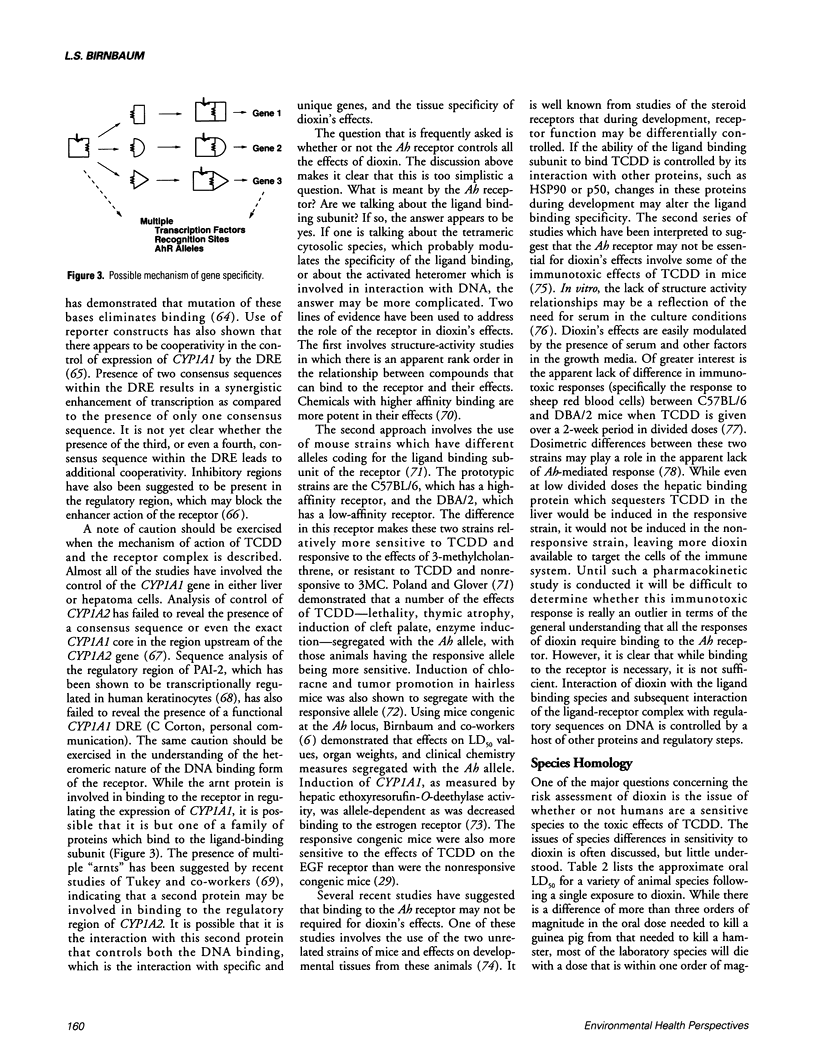
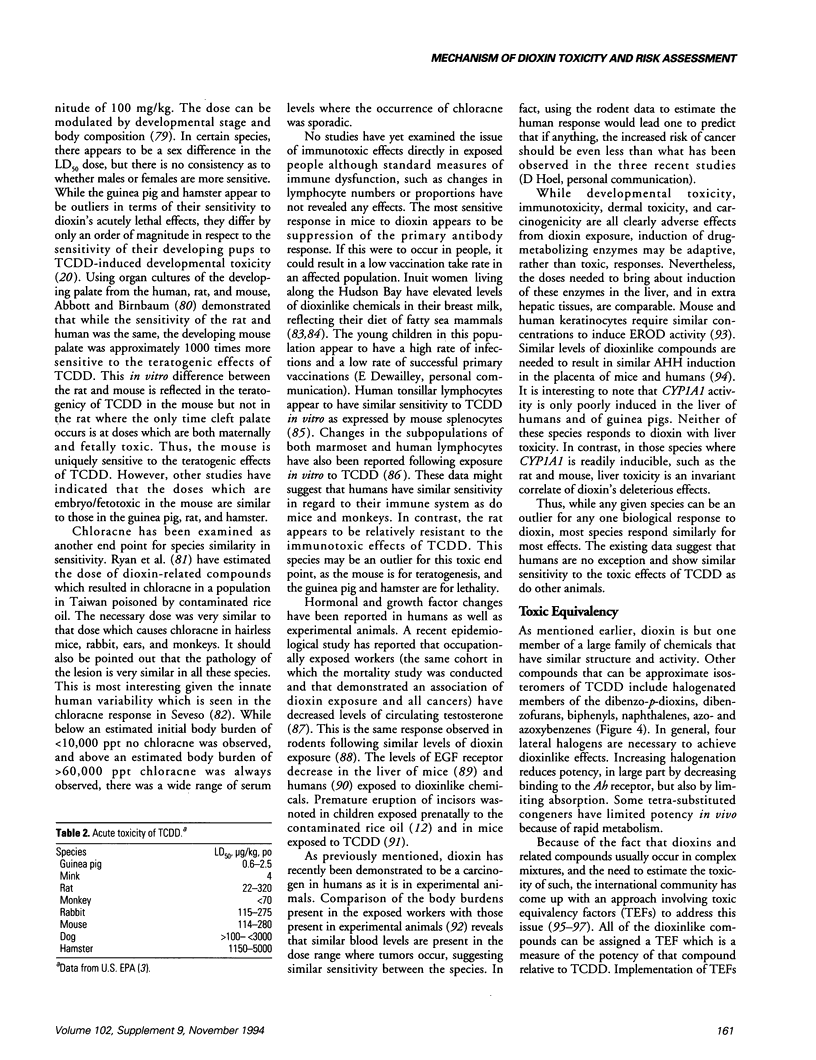
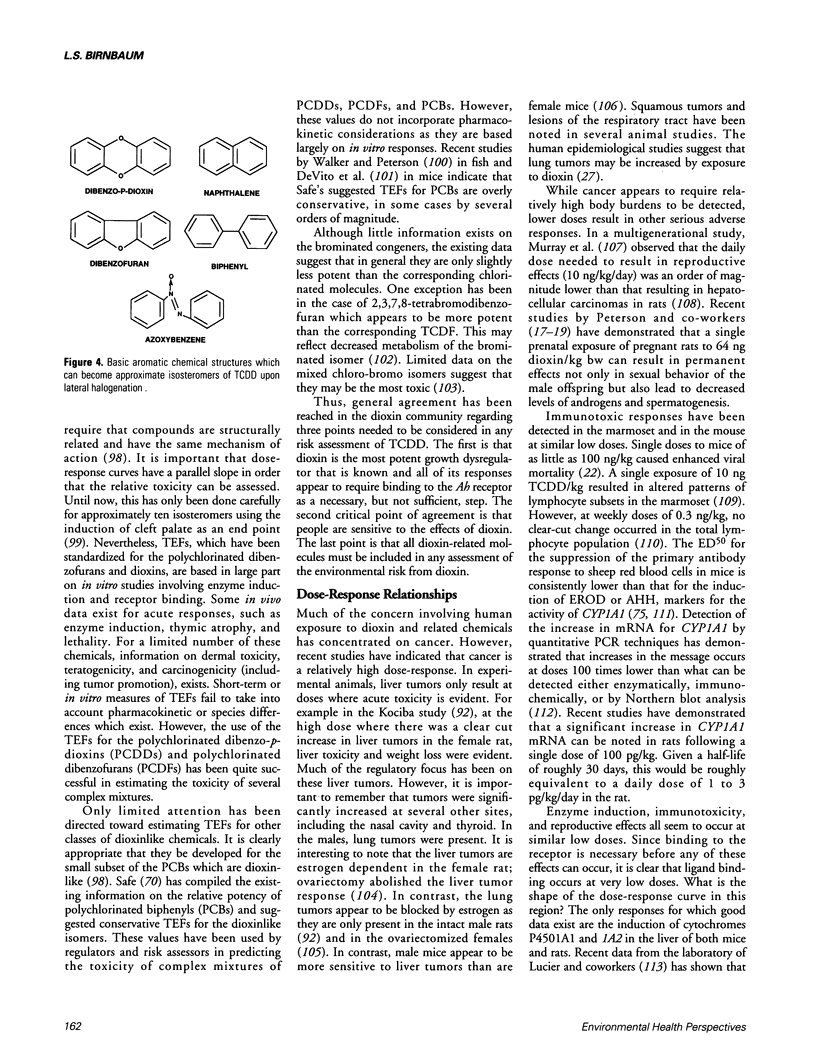
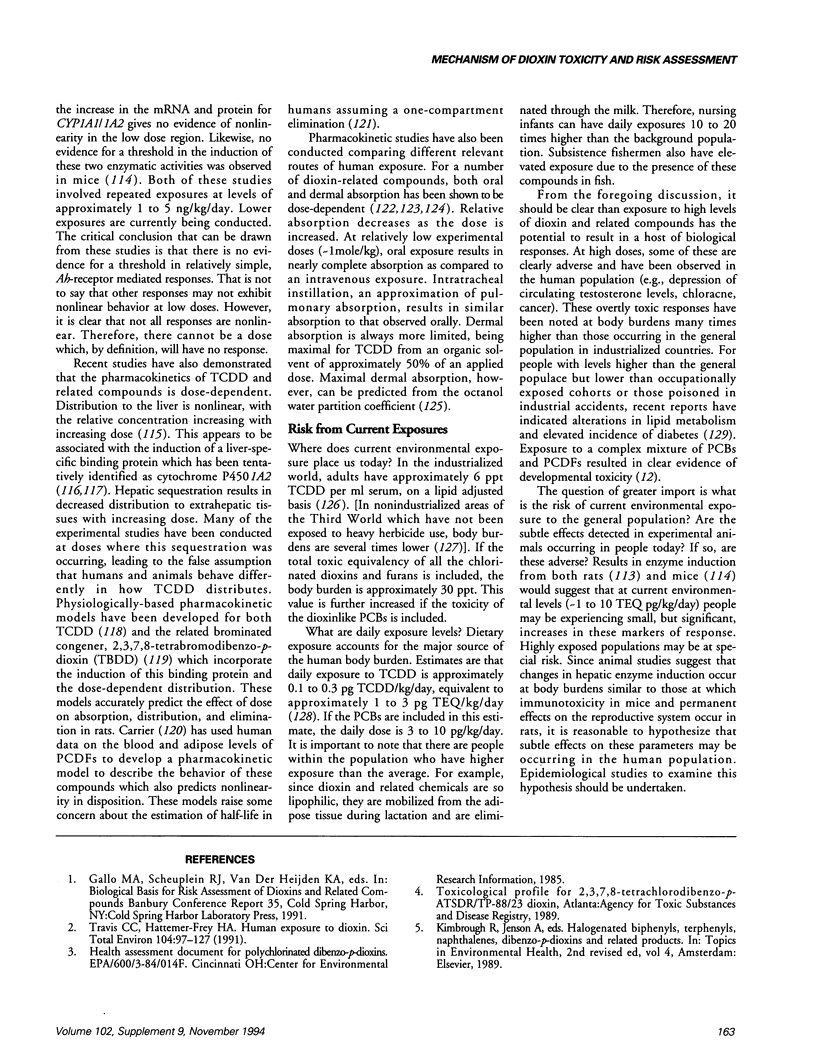
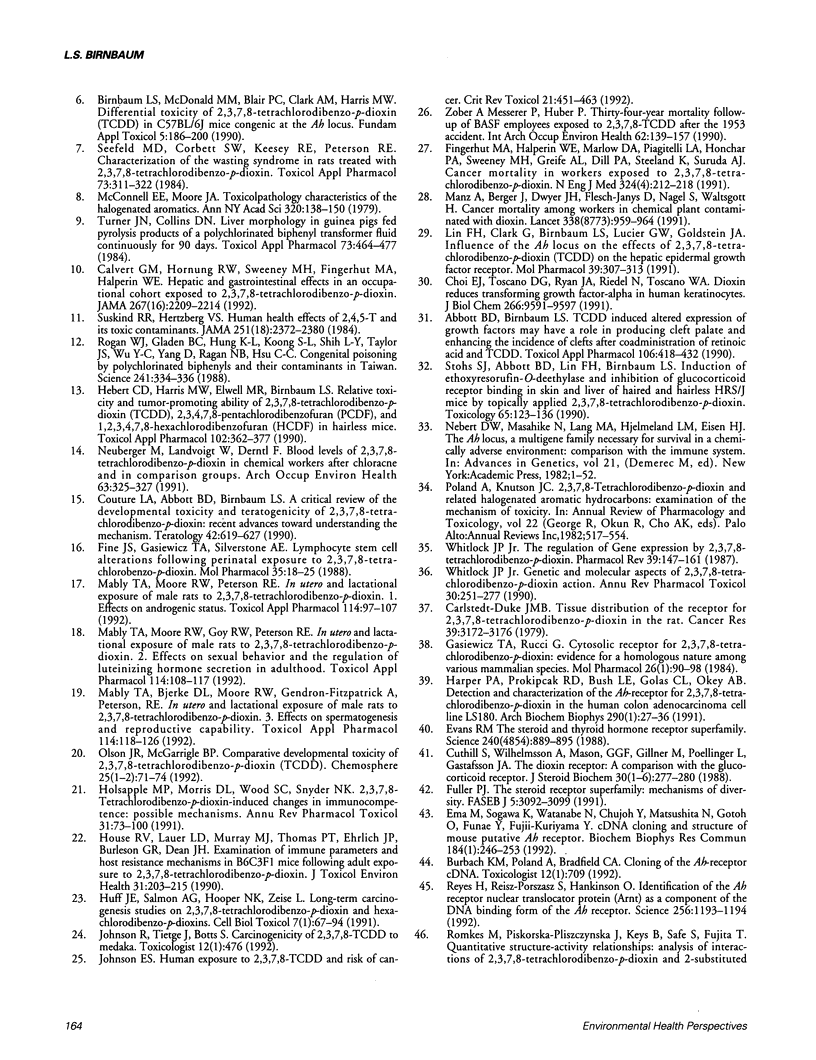
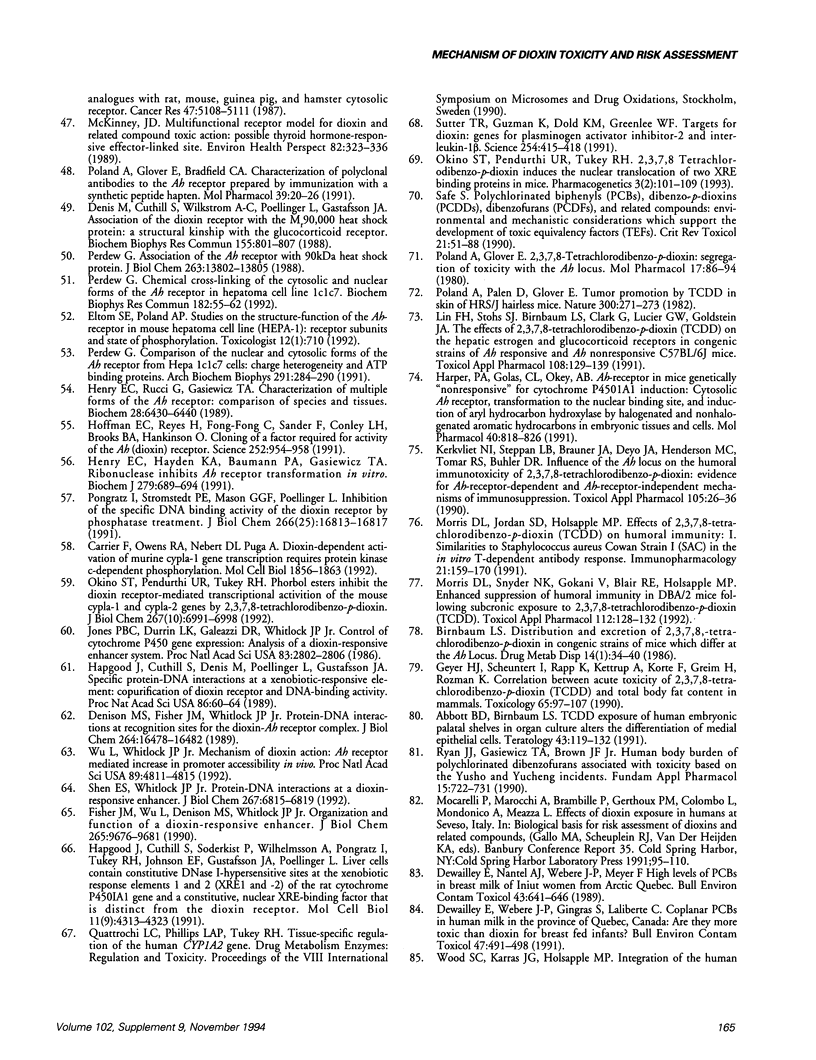
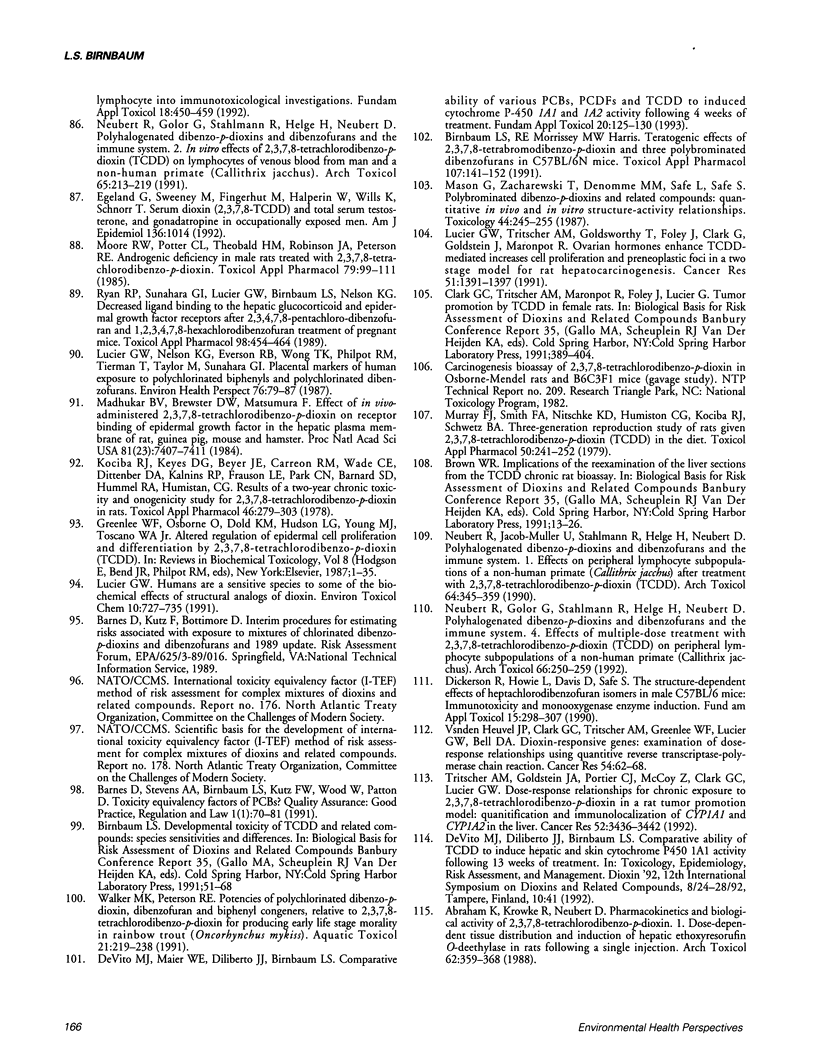
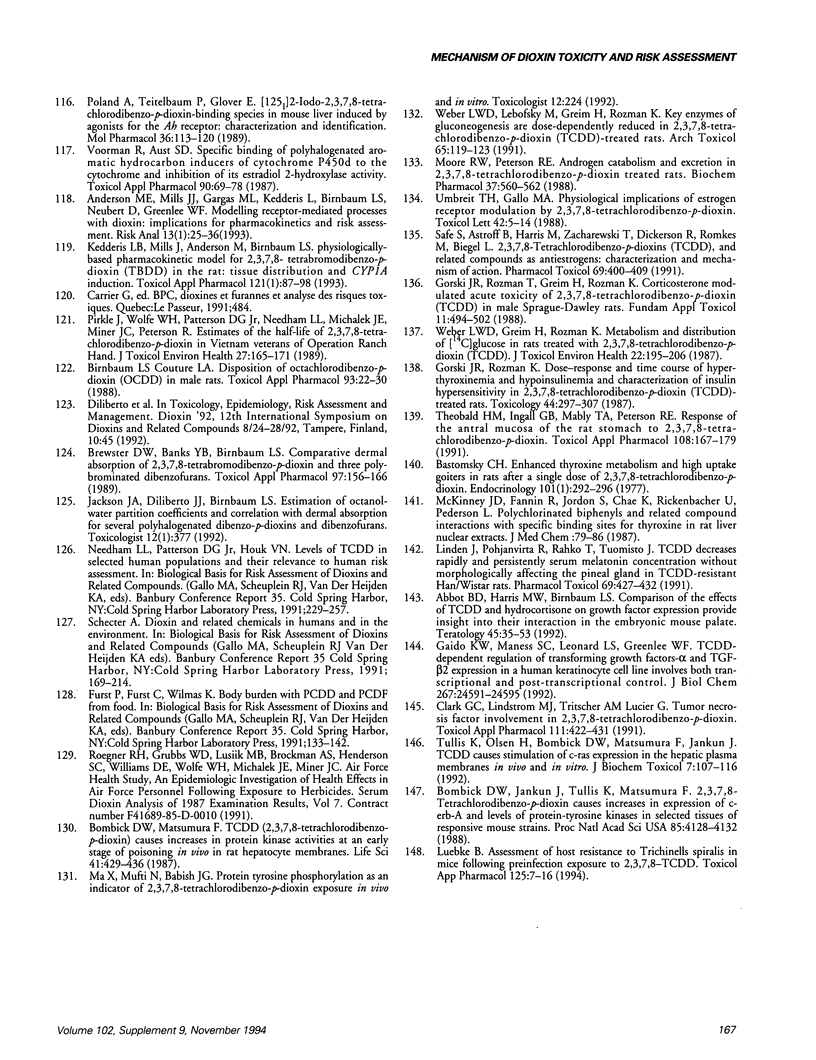
Selected References
These references are in PubMed. This may not be the complete list of references from this article.
- Abbott B. D., Birnbaum L. S. TCDD exposure of human embryonic palatal shelves in organ culture alters the differentiation of medial epithelial cells. Teratology. 1991 Feb;43(2):119–132. doi: 10.1002/tera.1420430205. [DOI] [PubMed] [Google Scholar]
- Abbott B. D., Birnbaum L. S. TCDD-induced altered expression of growth factors may have a role in producing cleft palate and enhancing the incidence of clefts after coadministration of retinoic acid and TCDD. Toxicol Appl Pharmacol. 1990 Dec;106(3):418–432. doi: 10.1016/0041-008x(90)90337-t. [DOI] [PubMed] [Google Scholar]
- Abbott B. D., Harris M. W., Birnbaum L. S. Comparisons of the effects of TCDD and hydrocortisone on growth factor expression provide insight into their interaction in the embryonic mouse palate. Teratology. 1992 Jan;45(1):35–53. doi: 10.1002/tera.1420450104. [DOI] [PubMed] [Google Scholar]
- Abraham K., Krowke R., Neubert D. Pharmacokinetics and biological activity of 2,3,7,8-tetrachlorodibenzo-p-dioxin. 1. Dose-dependent tissue distribution and induction of hepatic ethoxyresorufin O-deethylase in rats following a single injection. Arch Toxicol. 1988;62(5):359–368. doi: 10.1007/BF00293624. [DOI] [PubMed] [Google Scholar]
- Andersen M. E., Mills J. J., Gargas M. L., Kedderis L., Birnbaum L. S., Neubert D., Greenlee W. F. Modeling receptor-mediated processes with dioxin: implications for pharmacokinetics and risk assessment. Risk Anal. 1993 Feb;13(1):25–36. doi: 10.1111/j.1539-6924.1993.tb00726.x. [DOI] [PubMed] [Google Scholar]
- Barnes D., Alford-Stevens A., Birnbaum L., Kutz F. W., Wood W., Patton D. Toxicity equivalency factors for PCBs? Qual Assur. 1991 Oct;1(1):70–81. [PubMed] [Google Scholar]
- Bastomsky C. H. Enhanced thyroxine metabolism and high uptake goiters in rats after a single dose of 2,3,7,8-tetrachlorodibenzo-p-dioxin. Endocrinology. 1977 Jul;101(1):292–296. doi: 10.1210/endo-101-1-292. [DOI] [PubMed] [Google Scholar]
- Birnbaum L. S., Couture L. A. Disposition of octachlorodibenzo-p-dioxin (OCDD) in male rats. Toxicol Appl Pharmacol. 1988 Mar 30;93(1):22–30. doi: 10.1016/0041-008x(88)90022-1. [DOI] [PubMed] [Google Scholar]
- Birnbaum L. S. Distribution and excretion of 2,3,7,8-tetrachlorodibenzo-p-dioxin in congenic strains of mice which differ at the Ah locus. Drug Metab Dispos. 1986 Jan-Feb;14(1):34–40. [PubMed] [Google Scholar]
- Birnbaum L. S., McDonald M. M., Blair P. C., Clark A. M., Harris M. W. Differential toxicity of 2,3,7,8-tetrachlorodibenzo-p-dioxin (TCDD) in C57BL/6J mice congenic at the Ah Locus. Fundam Appl Toxicol. 1990 Jul;15(1):186–200. doi: 10.1016/0272-0590(90)90175-j. [DOI] [PubMed] [Google Scholar]
- Birnbaum L. S., Morrissey R. E., Harris M. W. Teratogenic effects of 2,3,7,8-tetrabromodibenzo-p-dioxin and three polybrominated dibenzofurans in C57BL/6N mice. Toxicol Appl Pharmacol. 1991 Jan;107(1):141–152. doi: 10.1016/0041-008x(91)90338-f. [DOI] [PubMed] [Google Scholar]
- Bombick D. W., Jankun J., Tullis K., Matsumura F. 2,3,7,8-Tetrachlorodibenzo-p-dioxin causes increases in expression of c-erb-A and levels of protein-tyrosine kinases in selected tissues of responsive mouse strains. Proc Natl Acad Sci U S A. 1988 Jun;85(12):4128–4132. doi: 10.1073/pnas.85.12.4128. [DOI] [PMC free article] [PubMed] [Google Scholar]
- Bombick D. W., Matsumura F. TCDD (2,3,7,8-tetrachlorodibenzo-p-dioxin) causes an increase in protein tyrosine kinase activities at an early stage of poisoning in vivo in rat hepatocyte membranes. Life Sci. 1987 Jul 27;41(4):429–436. doi: 10.1016/0024-3205(87)90218-9. [DOI] [PubMed] [Google Scholar]
- Brewster D. W., Banks Y. B., Clark A. M., Birnbaum L. S. Comparative dermal absorption of 2,3,7,8-tetrachlorodibenzo-p-dioxin and three polychlorinated dibenzofurans. Toxicol Appl Pharmacol. 1989 Jan;97(1):156–166. doi: 10.1016/0041-008x(89)90064-1. [DOI] [PubMed] [Google Scholar]
- Calvert G. M., Hornung R. W., Sweeney M. H., Fingerhut M. A., Halperin W. E. Hepatic and gastrointestinal effects in an occupational cohort exposed to 2,3,7,8-tetrachlorodibenzo-para-dioxin. JAMA. 1992 Apr 22;267(16):2209–2214. [PubMed] [Google Scholar]
- Carlstedt-Duke J. M. Tissue distribution of the receptor for 2,3,7,8-tetrachlorodibenzo-p-dioxin in the rat. Cancer Res. 1979 Aug;39(8):3172–3176. [PubMed] [Google Scholar]
- Choi E. J., Toscano D. G., Ryan J. A., Riedel N., Toscano W. A., Jr Dioxin induces transforming growth factor-alpha in human keratinocytes. J Biol Chem. 1991 May 25;266(15):9591–9597. [PubMed] [Google Scholar]
- Clark G. C., Taylor M. J., Tritscher A. M., Lucier G. W. Tumor necrosis factor involvement in 2,3,7,8-tetrachlorodibenzo-p-dioxin-mediated endotoxin hypersensitivity in C57BL/6J mice congenic at the Ah locus. Toxicol Appl Pharmacol. 1991 Dec;111(3):422–431. doi: 10.1016/0041-008x(91)90247-c. [DOI] [PubMed] [Google Scholar]
- Couture L. A., Abbott B. D., Birnbaum L. S. A critical review of the developmental toxicity and teratogenicity of 2,3,7,8-tetrachlorodibenzo-p-dioxin: recent advances toward understanding the mechanism. Teratology. 1990 Dec;42(6):619–627. doi: 10.1002/tera.1420420606. [DOI] [PubMed] [Google Scholar]
- Cuthill S., Wilhelmsson A., Mason G. G., Gillner M., Poellinger L., Gustafsson J. A. The dioxin receptor: a comparison with the glucocorticoid receptor. J Steroid Biochem. 1988;30(1-6):277–280. doi: 10.1016/0022-4731(88)90106-9. [DOI] [PubMed] [Google Scholar]
- De Vito M. J., Maier W. E., Diliberto J. J., Birnbaum L. S. Comparative ability of various PCBs, PCDFs, and TCDD to induce cytochrome P450 1A1 and 1A2 activity following 4 weeks of treatment. Fundam Appl Toxicol. 1993 Jan;20(1):125–130. [PubMed] [Google Scholar]
- Denis M., Cuthill S., Wikström A. C., Poellinger L., Gustafsson J. A. Association of the dioxin receptor with the Mr 90,000 heat shock protein: a structural kinship with the glucocorticoid receptor. Biochem Biophys Res Commun. 1988 Sep 15;155(2):801–807. doi: 10.1016/s0006-291x(88)80566-7. [DOI] [PubMed] [Google Scholar]
- Denison M. S., Fisher J. M., Whitlock J. P., Jr Protein-DNA interactions at recognition sites for the dioxin-Ah receptor complex. J Biol Chem. 1989 Oct 5;264(28):16478–16482. [PubMed] [Google Scholar]
- Dewailly E., Nantel A., Weber J. P., Meyer F. High levels of PCBs in breast milk of Inuit women from arctic Quebec. Bull Environ Contam Toxicol. 1989 Nov;43(5):641–646. doi: 10.1007/BF01701981. [DOI] [PubMed] [Google Scholar]
- Dewailly E., Weber J. P., Gingras S., Laliberté C. Coplanar PCBs in human milk in the province of Québec, Canada: are they more toxic than dioxin for breast fed infants? Bull Environ Contam Toxicol. 1991 Oct;47(4):491–498. doi: 10.1007/BF01700935. [DOI] [PubMed] [Google Scholar]
- Dickerson R., Howie L., Davis D., Safe S. The structure-dependent effects of heptachlorodibenzofuran isomers in male C57BL/6 mice: immunotoxicity and monooxygenase enzyme induction. Fundam Appl Toxicol. 1990 Aug;15(2):298–307. doi: 10.1016/0272-0590(90)90056-p. [DOI] [PubMed] [Google Scholar]
- Ema M., Sogawa K., Watanabe N., Chujoh Y., Matsushita N., Gotoh O., Funae Y., Fujii-Kuriyama Y. cDNA cloning and structure of mouse putative Ah receptor. Biochem Biophys Res Commun. 1992 Apr 15;184(1):246–253. doi: 10.1016/0006-291x(92)91185-s. [DOI] [PubMed] [Google Scholar]
- Evans R. M. The steroid and thyroid hormone receptor superfamily. Science. 1988 May 13;240(4854):889–895. doi: 10.1126/science.3283939. [DOI] [PMC free article] [PubMed] [Google Scholar]
- Fine J. S., Gasiewicz T. A., Silverstone A. E. Lymphocyte stem cell alterations following perinatal exposure to 2,3,7,8-tetrachlorodibenzo-p-dioxin. Mol Pharmacol. 1989 Jan;35(1):18–25. [PubMed] [Google Scholar]
- Fingerhut M. A., Halperin W. E., Marlow D. A., Piacitelli L. A., Honchar P. A., Sweeney M. H., Greife A. L., Dill P. A., Steenland K., Suruda A. J. Cancer mortality in workers exposed to 2,3,7,8-tetrachlorodibenzo-p-dioxin. N Engl J Med. 1991 Jan 24;324(4):212–218. doi: 10.1056/NEJM199101243240402. [DOI] [PubMed] [Google Scholar]
- Fisher J. M., Wu L., Denison M. S., Whitlock J. P., Jr Organization and function of a dioxin-responsive enhancer. J Biol Chem. 1990 Jun 15;265(17):9676–9681. [PubMed] [Google Scholar]
- Fuller P. J. The steroid receptor superfamily: mechanisms of diversity. FASEB J. 1991 Dec;5(15):3092–3099. doi: 10.1096/fasebj.5.15.1743440. [DOI] [PubMed] [Google Scholar]
- Gaido K. W., Maness S. C., Leonard L. S., Greenlee W. F. 2,3,7,8-Tetrachlorodibenzo-p-dioxin-dependent regulation of transforming growth factors-alpha and -beta 2 expression in a human keratinocyte cell line involves both transcriptional and post-transcriptional control. J Biol Chem. 1992 Dec 5;267(34):24591–24595. [PubMed] [Google Scholar]
- Gasiewicz T. A., Rucci G. Cytosolic receptor for 2,3,7,8-tetrachlorodibenzo-p-dioxin. Evidence for a homologous nature among various mammalian species. Mol Pharmacol. 1984 Jul;26(1):90–98. [PubMed] [Google Scholar]
- Geyer H. J., Scheuntert I., Rapp K., Kettrup A., Korte F., Greim H., Rozman K. Correlation between acute toxicity of 2,3,7,8-tetrachlorodibenzo-p-dioxin (TCDD) and total body fat content in mammals. Toxicology. 1990 Dec 17;65(1-2):97–107. doi: 10.1016/0300-483x(90)90081-q. [DOI] [PubMed] [Google Scholar]
- Gorski J. R., Rozman K. Dose-response and time course of hypothyroxinemia and hypoinsulinemia and characterization of insulin hypersensitivity in 2,3,7,8-tetrachlorodibenzo-p-dioxin (TCDD)-treated rats. Toxicology. 1987 Jun;44(3):297–307. doi: 10.1016/0300-483x(87)90031-x. [DOI] [PubMed] [Google Scholar]
- Gorski J. R., Rozman T., Greim H., Rozman K. Corticosterone modulates acute toxicity of 2,3,7,8-tetrachlorodibenzo-p-dioxin (TCDD) in male Sprague-Dawley rats. Fundam Appl Toxicol. 1988 Oct;11(3):494–502. doi: 10.1016/0272-0590(88)90113-3. [DOI] [PubMed] [Google Scholar]
- Hapgood J., Cuthill S., Denis M., Poellinger L., Gustafsson J. A. Specific protein-DNA interactions at a xenobiotic-responsive element: copurification of dioxin receptor and DNA-binding activity. Proc Natl Acad Sci U S A. 1989 Jan;86(1):60–64. doi: 10.1073/pnas.86.1.60. [DOI] [PMC free article] [PubMed] [Google Scholar]
- Hapgood J., Cuthill S., Söderkvist P., Wilhelmsson A., Pongratz I., Tukey R. H., Johnson E. F., Gustafsson J. A., Poellinger L. Liver cells contain constitutive DNase I-hypersensitive sites at the xenobiotic response elements 1 and 2 (XRE1 and -2) of the rat cytochrome P-450IA1 gene and a constitutive, nuclear XRE-binding factor that is distinct from the dioxin receptor. Mol Cell Biol. 1991 Sep;11(9):4314–4323. doi: 10.1128/mcb.11.9.4314. [DOI] [PMC free article] [PubMed] [Google Scholar]
- Harper P. A., Golas C. L., Okey A. B. Ah receptor in mice genetically "nonresponsive" for cytochrome P4501A1 induction: cytosolic Ah receptor, transformation to the nuclear binding state, and induction of aryl hydrocarbon hydroxylase by halogenated and nonhalogenated aromatic hydrocarbons in embryonic tissues and cells. Mol Pharmacol. 1991 Nov;40(5):818–826. [PubMed] [Google Scholar]
- Harper P. A., Prokipcak R. D., Bush L. E., Golas C. L., Okey A. B. Detection and characterization of the Ah receptor for 2,3,7,8-tetrachlorodibenzo-p-dioxin in the human colon adenocarcinoma cell line LS180. Arch Biochem Biophys. 1991 Oct;290(1):27–36. doi: 10.1016/0003-9861(91)90587-9. [DOI] [PubMed] [Google Scholar]
- Henry E. C., Hayden K. A., Bauman P. A., Gasiewicz T. A. Ribonuclease inhibits Ah receptor transformation in vitro. Biochem J. 1991 Nov 1;279(Pt 3):689–694. doi: 10.1042/bj2790689. [DOI] [PMC free article] [PubMed] [Google Scholar]
- Henry E. C., Rucci G., Gasiewicz T. A. Characterization of multiple forms of the Ah receptor: comparison of species and tissues. Biochemistry. 1989 Jul 25;28(15):6430–6440. doi: 10.1021/bi00441a041. [DOI] [PubMed] [Google Scholar]
- Hoffman E. C., Reyes H., Chu F. F., Sander F., Conley L. H., Brooks B. A., Hankinson O. Cloning of a factor required for activity of the Ah (dioxin) receptor. Science. 1991 May 17;252(5008):954–958. doi: 10.1126/science.1852076. [DOI] [PubMed] [Google Scholar]
- Holsapple M. P., Morris D. L., Wood S. C., Snyder N. K. 2,3,7,8-tetrachlorodibenzo-p-dioxin-induced changes in immunocompetence: possible mechanisms. Annu Rev Pharmacol Toxicol. 1991;31:73–100. doi: 10.1146/annurev.pa.31.040191.000445. [DOI] [PubMed] [Google Scholar]
- House R. V., Lauer L. D., Murray M. J., Thomas P. T., Ehrlich J. P., Burleson G. R., Dean J. H. Examination of immune parameters and host resistance mechanisms in B6C3F1 mice following adult exposure to 2,3,7,8-tetrachlorodibenzo-p-dioxin. J Toxicol Environ Health. 1990 Nov;31(3):203–215. doi: 10.1080/15287399009531449. [DOI] [PubMed] [Google Scholar]
- Huff J. E., Salmon A. G., Hooper N. K., Zeise L. Long-term carcinogenesis studies on 2,3,7,8-tetrachlorodibenzo-p-dioxin and hexachlorodibenzo-p-dioxins. Cell Biol Toxicol. 1991 Jan;7(1):67–94. doi: 10.1007/BF00121331. [DOI] [PubMed] [Google Scholar]
- Hébert C. D., Harris M. W., Elwell M. R., Birnbaum L. S. Relative toxicity and tumor-promoting ability of 2,3,7,8-tetrachlorodibenzo-p-dioxin (TCDD), 2,3,4,7,8-pentachlorodibenzofuran (PCDF), and 1,2,3,4,7,8-hexachlorodibenzofuran (HCDF) in hairless mice. Toxicol Appl Pharmacol. 1990 Feb;102(2):362–377. doi: 10.1016/0041-008x(90)90033-q. [DOI] [PubMed] [Google Scholar]
- Johnson E. S. Human exposure to 2,3,7,8-TCDD and risk of cancer. Crit Rev Toxicol. 1991;21(6):451–463. doi: 10.3109/10408449209089883. [DOI] [PubMed] [Google Scholar]
- Jones P. B., Durrin L. K., Galeazzi D. R., Whitlock J. P., Jr Control of cytochrome P1-450 gene expression: analysis of a dioxin-responsive enhancer system. Proc Natl Acad Sci U S A. 1986 May;83(9):2802–2806. doi: 10.1073/pnas.83.9.2802. [DOI] [PMC free article] [PubMed] [Google Scholar]
- Kedderis L. B., Mills J. J., Andersen M. E., Birnbaum L. S. A physiologically based pharmacokinetic model for 2,3,7,8-tetrabromodibenzo-p-dioxin (TBDD) in the rat: tissue distribution and CYP1A induction. Toxicol Appl Pharmacol. 1993 Jul;121(1):87–98. doi: 10.1006/taap.1993.1132. [DOI] [PubMed] [Google Scholar]
- Kerkvliet N. I., Steppan L. B., Brauner J. A., Deyo J. A., Henderson M. C., Tomar R. S., Buhler D. R. Influence of the Ah locus on the humoral immunotoxicity of 2,3,7,8-tetrachlorodibenzo-p-dioxin: evidence for Ah-receptor-dependent and Ah-receptor-independent mechanisms of immunosuppression. Toxicol Appl Pharmacol. 1990 Aug;105(1):26–36. doi: 10.1016/0041-008x(90)90356-y. [DOI] [PubMed] [Google Scholar]
- Kociba R. J., Keyes D. G., Beyer J. E., Carreon R. M., Wade C. E., Dittenber D. A., Kalnins R. P., Frauson L. E., Park C. N., Barnard S. D. Results of a two-year chronic toxicity and oncogenicity study of 2,3,7,8-tetrachlorodibenzo-p-dioxin in rats. Toxicol Appl Pharmacol. 1978 Nov;46(2):279–303. doi: 10.1016/0041-008x(78)90075-3. [DOI] [PubMed] [Google Scholar]
- Lin F. H., Clark G., Birnbaum L. S., Lucier G. W., Goldstein J. A. Influence of the Ah locus on the effects of 2,3,7,8-tetrachlorodibenzo-p-dioxin on the hepatic epidermal growth factor receptor. Mol Pharmacol. 1991 Mar;39(3):307–313. [PubMed] [Google Scholar]
- Lin F. H., Stohs S. J., Birnbaum L. S., Clark G., Lucier G. W., Goldstein J. A. The effects of 2,3,7,8-tetrachlorodibenzo-p-dioxin (TCDD) on the hepatic estrogen and glucocorticoid receptors in congenic strains of Ah responsive and Ah nonresponsive C57BL/6J mice. Toxicol Appl Pharmacol. 1991 Mar 15;108(1):129–139. doi: 10.1016/0041-008x(91)90276-k. [DOI] [PubMed] [Google Scholar]
- Linden J., Pohjanvirta R., Rahko T., Tuomisto J. TCDD decreases rapidly and persistently serum melatonin concentration without morphologically affecting the pineal gland in TCDD-resistant Han/Wistar rats. Pharmacol Toxicol. 1991 Dec;69(6):427–432. doi: 10.1111/j.1600-0773.1991.tb01325.x. [DOI] [PubMed] [Google Scholar]
- Lucier G. W., Nelson K. G., Everson R. B., Wong T. K., Philpot R. M., Tiernan T., Taylor M., Sunahara G. I. Placental markers of human exposure to polychlorinated biphenyls and polychlorinated dibenzofurans. Environ Health Perspect. 1987 Dec;76:79–87. doi: 10.1289/ehp.877679. [DOI] [PMC free article] [PubMed] [Google Scholar]
- Lucier G. W., Tritscher A., Goldsworthy T., Foley J., Clark G., Goldstein J., Maronpot R. Ovarian hormones enhance 2,3,7,8-tetrachlorodibenzo-p-dioxin-mediated increases in cell proliferation and preneoplastic foci in a two-stage model for rat hepatocarcinogenesis. Cancer Res. 1991 Mar 1;51(5):1391–1397. [PubMed] [Google Scholar]
- Luebke R. W., Copeland C. B., Diliberto J. J., Akubue P. I., Andrews D. L., Riddle M. M., Williams W. C., Birnbaum L. S. Assessment of host resistance to Trichinella spiralis in mice following preinfection exposure to 2,3,7,8-TCDD. Toxicol Appl Pharmacol. 1994 Mar;125(1):7–16. doi: 10.1006/taap.1994.1043. [DOI] [PubMed] [Google Scholar]
- Mably T. A., Bjerke D. L., Moore R. W., Gendron-Fitzpatrick A., Peterson R. E. In utero and lactational exposure of male rats to 2,3,7,8-tetrachlorodibenzo-p-dioxin. 3. Effects on spermatogenesis and reproductive capability. Toxicol Appl Pharmacol. 1992 May;114(1):118–126. doi: 10.1016/0041-008x(92)90103-y. [DOI] [PubMed] [Google Scholar]
- Mably T. A., Moore R. W., Goy R. W., Peterson R. E. In utero and lactational exposure of male rats to 2,3,7,8-tetrachlorodibenzo-p-dioxin. 2. Effects on sexual behavior and the regulation of luteinizing hormone secretion in adulthood. Toxicol Appl Pharmacol. 1992 May;114(1):108–117. doi: 10.1016/0041-008x(92)90102-x. [DOI] [PubMed] [Google Scholar]
- Mably T. A., Moore R. W., Peterson R. E. In utero and lactational exposure of male rats to 2,3,7,8-tetrachlorodibenzo-p-dioxin. 1. Effects on androgenic status. Toxicol Appl Pharmacol. 1992 May;114(1):97–107. doi: 10.1016/0041-008x(92)90101-w. [DOI] [PubMed] [Google Scholar]
- Madhukar B. V., Brewster D. W., Matsumura F. Effects of in vivo-administered 2,3,7,8-tetrachlorodibenzo-p-dioxin on receptor binding of epidermal growth factor in the hepatic plasma membrane of rat, guinea pig, mouse, and hamster. Proc Natl Acad Sci U S A. 1984 Dec;81(23):7407–7411. doi: 10.1073/pnas.81.23.7407. [DOI] [PMC free article] [PubMed] [Google Scholar]
- Manz A., Berger J., Dwyer J. H., Flesch-Janys D., Nagel S., Waltsgott H. Cancer mortality among workers in chemical plant contaminated with dioxin. Lancet. 1991 Oct 19;338(8773):959–964. doi: 10.1016/0140-6736(91)91835-i. [DOI] [PubMed] [Google Scholar]
- Mason G., Zacharewski T., Denomme M. A., Safe L., Safe S. Polybrominated dibenzo-p-dioxins and related compounds: quantitative in vivo and in vitro structure-activity relationships. Toxicology. 1987 Jun;44(3):245–255. doi: 10.1016/0300-483x(87)90027-8. [DOI] [PubMed] [Google Scholar]
- McConnell E. E., Moore J. A. Toxicopathology characteristics of the halogenated aromatics. Ann N Y Acad Sci. 1979 May 31;320:138–150. [PubMed] [Google Scholar]
- McKinney J. D. Multifunctional receptor model for dioxin and related compound toxic action: possible thyroid hormone-responsive effector-linked site. Environ Health Perspect. 1989 Jul;82:323–336. doi: 10.1289/ehp.8982323. [DOI] [PMC free article] [PubMed] [Google Scholar]
- Moore R. W., Peterson R. E. Androgen catabolism and excretion in 2,3,7,8-tetrachlorodibenzo-p-dioxin-treated rats. Biochem Pharmacol. 1988 Feb 1;37(3):560–562. doi: 10.1016/0006-2952(88)90232-8. [DOI] [PubMed] [Google Scholar]
- Moore R. W., Potter C. L., Theobald H. M., Robinson J. A., Peterson R. E. Androgenic deficiency in male rats treated with 2,3,7,8-tetrachlorodibenzo-p-dioxin. Toxicol Appl Pharmacol. 1985 Jun 15;79(1):99–111. doi: 10.1016/0041-008x(85)90372-2. [DOI] [PubMed] [Google Scholar]
- Morris D. L., Jordan S. D., Holsapple M. P. Effects of 2,3,7,8-tetrachlorodibenzo-p-dioxin (TCDD) on humoral immunity: I. Similarities to Staphylococcus aureus Cowan Strain I (SAC) in the in vitro T-dependent antibody response. Immunopharmacology. 1991 May-Jun;21(3):159–169. doi: 10.1016/0162-3109(91)90021-p. [DOI] [PubMed] [Google Scholar]
- Morris D. L., Snyder N. K., Gokani V., Blair R. E., Holsapple M. P. Enhanced suppression of humoral immunity in DBA/2 mice following subchronic exposure to 2,3,7,8-tetrachlorodibenzo-p-dioxin (TCDD). Toxicol Appl Pharmacol. 1992 Jan;112(1):128–132. doi: 10.1016/0041-008x(92)90288-4. [DOI] [PubMed] [Google Scholar]
- Murray F. J., Smith F. A., Nitschke K. D., Humiston C. G., Kociba R. J., Schwetz B. A. Three-generation reproduction study of rats given 2,3,7,8-tetrachlorodibenzo-p-dioxin (TCDD) in the diet. Toxicol Appl Pharmacol. 1979 Sep 15;50(2):241–252. doi: 10.1016/0041-008x(79)90149-2. [DOI] [PubMed] [Google Scholar]
- Nebert D. W., Negishi M., Lang M. A., Hjelmeland L. M., Eisen H. J. The Ah locus, a multigene family necessary for survival in a chemically adverse environment: comparison with the immune system. Adv Genet. 1982;21:1–52. doi: 10.1016/s0065-2660(08)60296-5. [DOI] [PubMed] [Google Scholar]
- Neuberger M., Landvoigt W., Derntl F. Blood levels of 2,3,7,8-tetrachlorodibenzo-p-dioxin in chemical workers after chloracne and in comparison groups. Int Arch Occup Environ Health. 1991;63(5):325–327. doi: 10.1007/BF00381582. [DOI] [PubMed] [Google Scholar]
- Neubert R., Golor G., Stahlmann R., Helge H., Neubert D. Polyhalogenated dibenzo-p-dioxins and dibenzofurans and the immune system. 4. Effects of multiple-dose treatment with 2,3,7,8-tetrachlorodibenzo-p-dioxin (TCDD) on peripheral lymphocyte subpopulations of a non-human primate (Callithrix jacchus). Arch Toxicol. 1992;66(4):250–259. doi: 10.1007/BF02307170. [DOI] [PubMed] [Google Scholar]
- Neubert R., Jacob-Müller U., Helge H., Stahlmann R., Neubert D. Polyhalogenated dibenzo-p-dioxins and dibenzofurans and the immune system. 2. In vitro effects of 2,3,7,8-tetrachlorodibenzo-p-dioxin (TCDD) on lymphocytes of venous blood from man and a non-human primate (Callithrix jacchus). Arch Toxicol. 1991;65(3):213–219. doi: 10.1007/BF02307311. [DOI] [PubMed] [Google Scholar]
- Neubert R., Jacob-Müller U., Stahlmann R., Helge H., Neubert D. Polyhalogenated dibenzo-p-dioxins and dibenzofurans and the immune system. 1. Effects on peripheral lymphocyte subpopulations of a non-human primate (Callithrix jacchus) after treatment with 2,3,7,8-tetrachlorodibenzo-p-dioxin (TCDD). Arch Toxicol. 1990;64(5):345–359. doi: 10.1007/BF01973455. [DOI] [PubMed] [Google Scholar]
- Okino S. T., Pendurthi U. R., Tukey R. H. 2,3,7,8-Tetrachlorodibenzo-p-dioxin induces the nuclear translocation of two XRE binding proteins in mice. Pharmacogenetics. 1993 Apr;3(2):101–109. doi: 10.1097/00008571-199304000-00006. [DOI] [PubMed] [Google Scholar]
- Okino S. T., Pendurthi U. R., Tukey R. H. Phorbol esters inhibit the dioxin receptor-mediated transcriptional activation of the mouse Cyp1a-1 and Cyp1a-2 genes by 2,3,7,8-tetrachlorodibenzo-p-dioxin. J Biol Chem. 1992 Apr 5;267(10):6991–6998. [PubMed] [Google Scholar]
- Perdew G. H. Association of the Ah receptor with the 90-kDa heat shock protein. J Biol Chem. 1988 Sep 25;263(27):13802–13805. [PubMed] [Google Scholar]
- Perdew G. H. Chemical cross-linking of the cytosolic and nuclear forms of the Ah receptor in hepatoma cell line 1c1c7. Biochem Biophys Res Commun. 1992 Jan 15;182(1):55–62. doi: 10.1016/s0006-291x(05)80111-1. [DOI] [PubMed] [Google Scholar]
- Perdew G. H. Comparison of the nuclear and cytosolic forms of the Ah receptor from Hepa 1c1c7 cells: charge heterogeneity and ATP binding properties. Arch Biochem Biophys. 1991 Dec;291(2):284–290. doi: 10.1016/0003-9861(91)90136-7. [DOI] [PubMed] [Google Scholar]
- Pirkle J. L., Wolfe W. H., Patterson D. G., Needham L. L., Michalek J. E., Miner J. C., Peterson M. R., Phillips D. L. Estimates of the half-life of 2,3,7,8-tetrachlorodibenzo-p-dioxin in Vietnam Veterans of Operation Ranch Hand. J Toxicol Environ Health. 1989;27(2):165–171. doi: 10.1080/15287398909531288. [DOI] [PubMed] [Google Scholar]
- Poland A., Glover E. 2,3,7,8,-Tetrachlorodibenzo-p-dioxin: segregation of toxocity with the Ah locus. Mol Pharmacol. 1980 Jan;17(1):86–94. [PubMed] [Google Scholar]
- Poland A., Glover E., Bradfield C. A. Characterization of polyclonal antibodies to the Ah receptor prepared by immunization with a synthetic peptide hapten. Mol Pharmacol. 1991 Jan;39(1):20–26. [PubMed] [Google Scholar]
- Poland A., Knutson J. C. 2,3,7,8-tetrachlorodibenzo-p-dioxin and related halogenated aromatic hydrocarbons: examination of the mechanism of toxicity. Annu Rev Pharmacol Toxicol. 1982;22:517–554. doi: 10.1146/annurev.pa.22.040182.002505. [DOI] [PubMed] [Google Scholar]
- Poland A., Palen D., Glover E. Tumour promotion by TCDD in skin of HRS/J hairless mice. Nature. 1982 Nov 18;300(5889):271–273. doi: 10.1038/300271a0. [DOI] [PubMed] [Google Scholar]
- Poland A., Teitelbaum P., Glover E. [125I]2-iodo-3,7,8-trichlorodibenzo-p-dioxin-binding species in mouse liver induced by agonists for the Ah receptor: characterization and identification. Mol Pharmacol. 1989 Jul;36(1):113–120. [PubMed] [Google Scholar]
- Pongratz I., Strömstedt P. E., Mason G. G., Poellinger L. Inhibition of the specific DNA binding activity of the dioxin receptor by phosphatase treatment. J Biol Chem. 1991 Sep 5;266(25):16813–16817. [PubMed] [Google Scholar]
- Reyes H., Reisz-Porszasz S., Hankinson O. Identification of the Ah receptor nuclear translocator protein (Arnt) as a component of the DNA binding form of the Ah receptor. Science. 1992 May 22;256(5060):1193–1195. doi: 10.1126/science.256.5060.1193. [DOI] [PubMed] [Google Scholar]
- Rogan W. J., Gladen B. C., Hung K. L., Koong S. L., Shih L. Y., Taylor J. S., Wu Y. C., Yang D., Ragan N. B., Hsu C. C. Congenital poisoning by polychlorinated biphenyls and their contaminants in Taiwan. Science. 1988 Jul 15;241(4863):334–336. doi: 10.1126/science.3133768. [DOI] [PubMed] [Google Scholar]
- Romkes M., Piskorska-Pliszczynska J., Keys B., Safe S., Fujita T. Quantitative structure-activity relationships: analysis of interactions of 2,3,7,8-tetrachlorodibenzo-p-dioxin and 2-substituted analogues with rat, mouse, guinea pig, and hamster cytosolic receptor. Cancer Res. 1987 Oct 1;47(19):5108–5111. [PubMed] [Google Scholar]
- Ryan J. J., Gasiewicz T. A., Brown J. F., Jr Human body burden of polychlorinated dibenzofurans associated with toxicity based on the yusho and yucheng incidents. Fundam Appl Toxicol. 1990 Nov;15(4):722–731. doi: 10.1016/0272-0590(90)90188-p. [DOI] [PubMed] [Google Scholar]
- Ryan R. P., Sunahara G. I., Lucier G. W., Birnbaum L. S., Nelson K. G. Decreased ligand binding to the hepatic glucocorticoid and epidermal growth factor receptors after 2,3,4,7,8-pentachlorodibenzofuran and 1,2,3,4,7,8-hexachlorodibenzofuran treatment of pregnant mice. Toxicol Appl Pharmacol. 1989 May;98(3):454–464. doi: 10.1016/0041-008x(89)90174-9. [DOI] [PubMed] [Google Scholar]
- Safe S., Astroff B., Harris M., Zacharewski T., Dickerson R., Romkes M., Biegel L. 2,3,7,8-Tetrachlorodibenzo-p-dioxin (TCDD) and related compounds as antioestrogens: characterization and mechanism of action. Pharmacol Toxicol. 1991 Dec;69(6):400–409. doi: 10.1111/j.1600-0773.1991.tb01321.x. [DOI] [PubMed] [Google Scholar]
- Safe S. Polychlorinated biphenyls (PCBs), dibenzo-p-dioxins (PCDDs), dibenzofurans (PCDFs), and related compounds: environmental and mechanistic considerations which support the development of toxic equivalency factors (TEFs). Crit Rev Toxicol. 1990;21(1):51–88. doi: 10.3109/10408449009089873. [DOI] [PubMed] [Google Scholar]
- Seefeld M. D., Corbett S. W., Keesey R. E., Peterson R. E. Characterization of the wasting syndrome in rats treated with 2,3,7,8-tetrachlorodibenzo-p-dioxin. Toxicol Appl Pharmacol. 1984 Apr;73(2):311–322. doi: 10.1016/0041-008x(84)90337-5. [DOI] [PubMed] [Google Scholar]
- Shen E. S., Whitlock J. P., Jr Protein-DNA interactions at a dioxin-responsive enhancer. Mutational analysis of the DNA-binding site for the liganded Ah receptor. J Biol Chem. 1992 Apr 5;267(10):6815–6819. [PubMed] [Google Scholar]
- Stohs S. J., Abbott B. D., Lin F. H., Birnbaum L. S. Induction of ethoxyresorufin-O-deethylase and inhibition of glucocorticoid receptor binding in skin and liver of haired and hairless HRS/J mice by topically applied 2,3,7,8-tetrachlorodibenzo-p-dioxin. Toxicology. 1990 Dec 17;65(1-2):123–136. doi: 10.1016/0300-483x(90)90083-s. [DOI] [PubMed] [Google Scholar]
- Suskind R. R., Hertzberg V. S. Human health effects of 2,4,5-T and its toxic contaminants. JAMA. 1984 May 11;251(18):2372–2380. [PubMed] [Google Scholar]
- Sutter T. R., Guzman K., Dold K. M., Greenlee W. F. Targets for dioxin: genes for plasminogen activator inhibitor-2 and interleukin-1 beta. Science. 1991 Oct 18;254(5030):415–418. doi: 10.1126/science.1925598. [DOI] [PubMed] [Google Scholar]
- Theobald H. M., Ingall G. B., Mably T. A., Peterson R. E. Response of the antral mucosa of the rat stomach to 2,3,7,8-tetrachlorodibenzo-p-dioxin. Toxicol Appl Pharmacol. 1991 Mar 15;108(1):167–179. doi: 10.1016/0041-008x(91)90280-r. [DOI] [PubMed] [Google Scholar]
- Travis C. C., Hattemer-Frey H. A. Human exposure to dioxin. Sci Total Environ. 1991 May 1;104(1-2):97–127. doi: 10.1016/0048-9697(91)90010-c. [DOI] [PubMed] [Google Scholar]
- Tritscher A. M., Goldstein J. A., Portier C. J., McCoy Z., Clark G. C., Lucier G. W. Dose-response relationships for chronic exposure to 2,3,7,8-tetrachlorodibenzo-p-dioxin in a rat tumor promotion model: quantification and immunolocalization of CYP1A1 and CYP1A2 in the liver. Cancer Res. 1992 Jun 15;52(12):3436–3442. [PubMed] [Google Scholar]
- Tullis K., Olsen H., Bombick D. W., Matsumura F., Jankun J. TCDD causes stimulation of c-ras expression in the hepatic plasma membranes in vivo and in vitro. J Biochem Toxicol. 1992 Summer;7(2):107–116. doi: 10.1002/jbt.2570070208. [DOI] [PubMed] [Google Scholar]
- Turner J. N., Collins D. N. Liver morphology in guinea pigs fed pyrolysis products of a polychlorinated biphenyl transformer fluid continuously for 90 days. Toxicol Appl Pharmacol. 1984 May;73(3):464–477. doi: 10.1016/0041-008x(84)90099-1. [DOI] [PubMed] [Google Scholar]
- Umbreit T. H., Gallo M. A. Physiological implications of estrogen receptor modulation by 2,3,7,8-tetrachlorodibenzo-p-dioxin. Toxicol Lett. 1988 Jul;42(1):5–14. doi: 10.1016/0378-4274(88)90097-5. [DOI] [PubMed] [Google Scholar]
- Voorman R., Aust S. D. Specific binding of polyhalogenated aromatic hydrocarbon inducers of cytochrome P-450d to the cytochrome and inhibition of its estradiol 2-hydroxylase activity. Toxicol Appl Pharmacol. 1987 Aug;90(1):69–78. doi: 10.1016/0041-008x(87)90307-3. [DOI] [PubMed] [Google Scholar]
- Weber L. W., Greim H., Rozman K. K. Metabolism and distribution of [14C]glucose in rats treated with 2,3,7,8-tetrachlorodibenzo-p-dioxin (TCDD). J Toxicol Environ Health. 1987;22(2):195–206. doi: 10.1080/15287398709531063. [DOI] [PubMed] [Google Scholar]
- Weber L. W., Lebofsky M., Greim H., Rozman K. Key enzymes of gluconeogenesis are dose-dependently reduced in 2,3,7,8-tetrachlorodibenzo-p-dioxin (TCDD)-treated rats. Arch Toxicol. 1991;65(2):119–123. doi: 10.1007/BF02034937. [DOI] [PubMed] [Google Scholar]
- Whitlock J. P., Jr Genetic and molecular aspects of 2,3,7,8-tetrachlorodibenzo-p-dioxin action. Annu Rev Pharmacol Toxicol. 1990;30:251–277. doi: 10.1146/annurev.pa.30.040190.001343. [DOI] [PubMed] [Google Scholar]
- Whitlock J. P., Jr The regulation of gene expression by 2,3,7,8-tetrachlorodibenzo-p-dioxin. Pharmacol Rev. 1987 Jun;39(2):147–161. [PubMed] [Google Scholar]
- Wu L., Whitlock J. P., Jr Mechanism of dioxin action: Ah receptor-mediated increase in promoter accessibility in vivo. Proc Natl Acad Sci U S A. 1992 Jun 1;89(11):4811–4815. doi: 10.1073/pnas.89.11.4811. [DOI] [PMC free article] [PubMed] [Google Scholar]
- Zober A., Messerer P., Huber P. Thirty-four-year mortality follow-up of BASF employees exposed to 2,3,7,8-TCDD after the 1953 accident. Int Arch Occup Environ Health. 1990;62(2):139–157. doi: 10.1007/BF00383591. [DOI] [PubMed] [Google Scholar]


